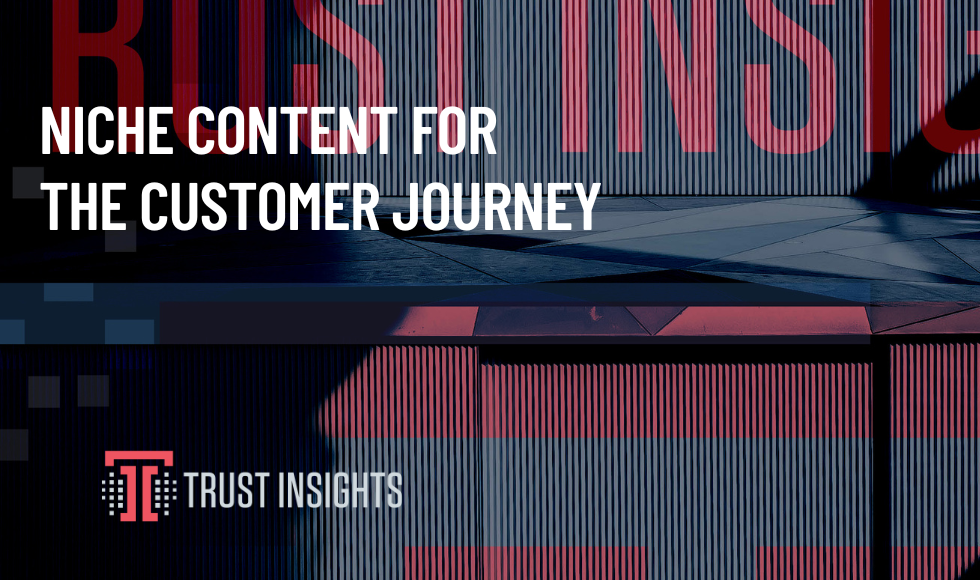Do you create niche content? Do you know your customer journey? Have you ever thought of combining the two so that you’re creating niche content for the customer journey?
This got me thinking about content planning. In an ideal world, we could be everything to everyone. In the real world, we’re trying to reach our audience at a specific point in their customer journey when they need our content the most. This could be awareness, purchase, or every stage between. Thus demonstrating that you cannot be everything to everyone. Your awareness content won’t hit the same as the hard sell.
So – why can’t we do both? Why can’t we create niche content and mass appeal content?
You can. In my experience, companies that lean toward mass appeal content do so because they don’t have a great grasp of their customer journey. They don’t know the timing or the channels. It’s also easier to create mass appeal content (but that’s a topic for another time). What happens is they mismatch platforms and messaging and don’t provide specific information. It can be difficult to pinpoint when someone is at a specific stage of your customer journey if they are not live on your website.
I just had an interesting conversation with my friend Brooke Sellas from B Squared Media and she is working on this really cool measurement concept that tags social conversation for different customer journey stages. And it got me thinking – is this the solution I didn’t know I needed? Spoiler – the answer is yes.
When we (Trust Insights) do an attribution report we’re limited to understanding what comes into our website through different marketing channels. This is useful because we can make sure we’re reaching people at their appropriate customer journey stage and create content around that. The challenge is that perhaps the majority of our email subscriber list is at the engagement stage, but not everyone is. We don’t know that for certain with our reporting. So we throw in some language that sells our services. We make sure that we give context to who we are and what we do. We’re back to trying to be everything to everyone. And not everything happens on our website. To assume so would be incorrect.
And limiting yourself to only what happens on your site is reactive. I want to be more proactive and in the moment. I want to reach people before they even know we exist.
That’s where Brooke’s work is useful. She’s using social listening software and training the system to identify conversations around specific keywords and topics for different customer journey phases.
It blew my mind. It’s so simple, yet so genius.
What this does is allow companies to create that niche content for different audience segments and have it at the ready. Instead of broadcasting “This is what we do” on social media to everyone all the time, you can narrow down your focus and share that message with people who are ready to hear it. You’re not guessing. You’re cutting out the noise.
Like I said, mind blown.
This brings us to the “so what” this week. You should create broad and niche content. Broad content is for everyday use. It’s evergreen, it’s for anyone. Niche content is for select groups at select times. You need both in your arsenal. Start by figuring out what are the stages your customers go through on your sales funnel. Those are your customer journey phases. Then take a look at what they are doing in those phases. What do they typically engage with on your website? What kinds of questions do they ask? That will help you understand what they care about.
Think about it like this. If a prospect comes to you and says, “I’m interested in your blue widget, what are the technical requirements?” you want to have an FAQ ready. If all you have is a company overview, you’ve missed an opportunity. Don’t limit yourself to what happens on your website and don’t overlook the power of social listening.
If you want to check out Brooke’s new book, you can find it here:
Are you using social listening to reach people? Come tell me about it in our Free Slack Community, Analytics for Marketers!
|
Need help with your marketing AI and analytics? |
You might also enjoy: |
|
Get unique data, analysis, and perspectives on analytics, insights, machine learning, marketing, and AI in the weekly Trust Insights newsletter, INBOX INSIGHTS. Subscribe now for free; new issues every Wednesday! |
Want to learn more about data, analytics, and insights? Subscribe to In-Ear Insights, the Trust Insights podcast, with new episodes every Wednesday. |






